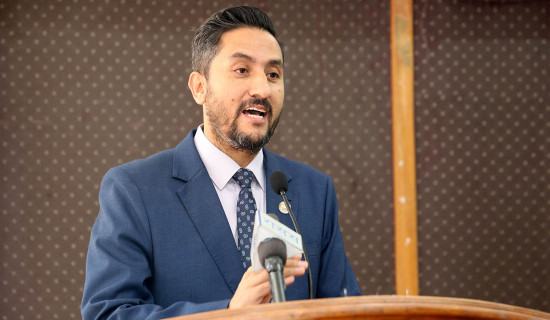- Wednesday, 17 December 2025
Ensure Safety In Air Travel
Yug Bahadur
We all are shocked when we hear about the news of one or other air mishaps. It was no different when a Twin Otter aircraft belonging to a domestic private airline met with an accident when it was flying a short distance from Pokhara, a much liked place by both international and domestic travellers, to Jomsom, another tourist destination in the hilly areas of Nepal. This really shocked many people as the tragedy took place nearby. But now, we will not dwell only on this one incident of the Tara Air Twin Otter crash in a mountainous area. We will also talk of the difficult terrain of the country as well. Nepal is known for its beautiful mountains, the rolling hills and rich historical sites within a very small area.
Alternative airports
Nepal is a rectangular shaped country with beautiful virgin hilly areas and some of the highest mountains of the world towards its north and very little space of plain areas to the south. It is very important to Nepalis and others that alternative airports be built elsewhere as well, besides the only long ago established international airport in capital Kathmandu. Another international airport has already been in operation for a few months now but the other international airport in Nijgadh has been embroiled in controversy due to the insistence of environmental activists who say that this airport should not be built due to environmental reasons.
The political parties who adamantly say that as the government has already spent a huge amount of its precious funds to build the airport, this work should not be dragged into the game of who is right and who is wrong now at the last moment. The Supreme Court has recently issued a verdict against the construction of the international airport in Nijgadh. It may be recalled that environmentalists had also been successful in scrapping of the Arun III Hydropower Project because it was believed that sound of the helicopters carrying construction materials would be harmful for different species of fishes which thrived in the waters of that river.
Nepal had to pay a heavy price for not constructing Arun III project and the people had to suffer for many years to come. But these very environmentalists have been deafeningly silent when the same project has started being built by another foreign company. It seems these environmentalists were more interested in personal glory and gains rather than the welfare of the people. Now they are all set to take back the country to the ‘dark ages’ and give a blind eye to how their decisions may affect the development of the nation as a whole. But of course these people had the clout to meet World Bank policy makers and other influential individuals in developed countries who had promised huge funds for the Arun III project.
At that time a high ranking US State Department official had asked this writer over dinner at a resort nearby Kathmandu, what he thought of ‘load-shedding in Nepal’? This writer in a blunt manner had replied that no sane Nepali ever thought that this would be a problem in their day to day life. And this was before the time when Nepalis had to suffer from 18 hours of load-shedding on a daily basis and development works came to a grinding halt and many medium-sized industries were forced to close down.
But now to go back to the issue which we started with, most of us understand that when such tragedies take place in faraway places, it just becomes statistics. But when mishaps whether accidents or man-made take place in your own backyard, it becomes a saddening news which is traumatic. The people were more saddened to learn that seven people from the same family also perished, when they had flown in the ill-fated aircraft of Tara Air to go to Muktinath, a temple which is revered by both Hindus and Buddhists.
To delve a little into the country’s history, Nepal had freed itself from the dictatorial family rule of visionless Ranas. With the opening of the country to a modern democracy, development started to take place and a five-year development plan was set out. Still due to various political reasons, though Nepal was connected by air and roads to the outside world, the aviation sector really took off only after a sturdy open market policy was introduced after another revolution in 1990. Thus soon after this, a real open market policy was established and private airlines beside the national flag carrier Nepal Airlines Corporation, took wings in the skies and Nepal was connected to different parts of the country and also in the international map in a big way.
One thing which should not be overlooked is that constructing roads in the far-flung areas was not possible, and many STOL (short take-off and landing) airports were built and Twin Otters were the best option in such terrain. This not only connected the people of Nepal but it also really opened the country for outsiders to come here and for Nepali citizens to go abroad. There was a time when just a few airlines connected Nepal to the outside world, mainly India, but now that there are several flights from the Middle East to Kathmandu on a daily basis, which can connect you to places as far off as America.
Mishaps galore
However sadly, more flights in Nepal have also caused many accidents which have taken place here. According to the Civil Aviation Authority of Nepal (CAAN) sources, 59 air mishaps have taken place in Nepal with 828 people having lost their lives. Most of the accidents have taken place between mid-May and mid-September. This is the time when it is dangerous to travel by air and also by roads in the hilly areas, as the monsoon season will create all sorts of problems, including low visibility for aircraft flyers, floods, landslides and bad road conditions for vehicle drivers.
It is good that a high level investigation team has been constituted by the authorities to look into the Tara Air accident, but apart from blaming human error alone for such mishaps the aspect of conditions of aircraft or passenger vehicles is also taken notice of. It is hoped that some concrete decisions are made to avoid such accidents in the future and rules will be seriously implemented to save people from losing their lives just because of the carelessness on the part of officials or technicians.
(The author is a freelance writer.)
















